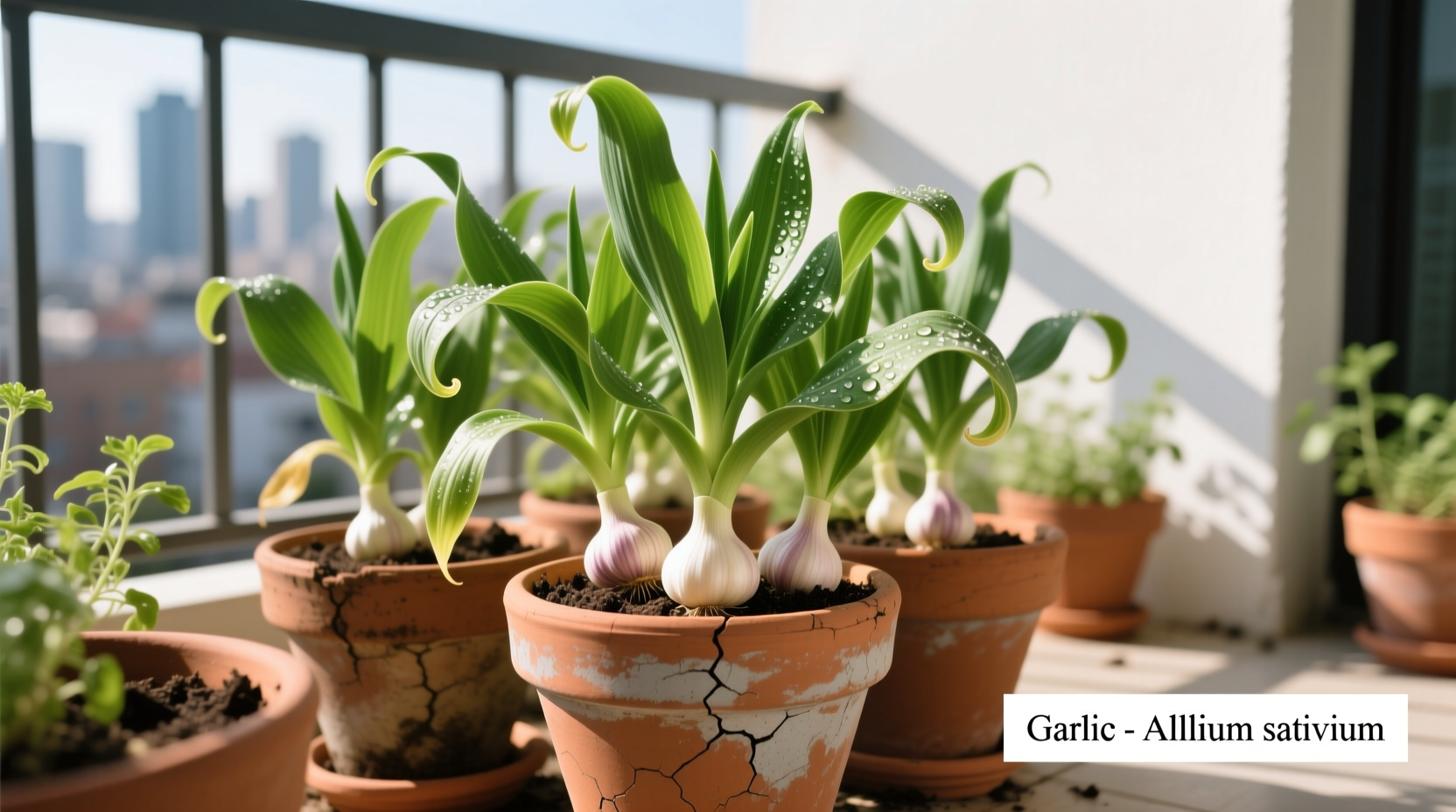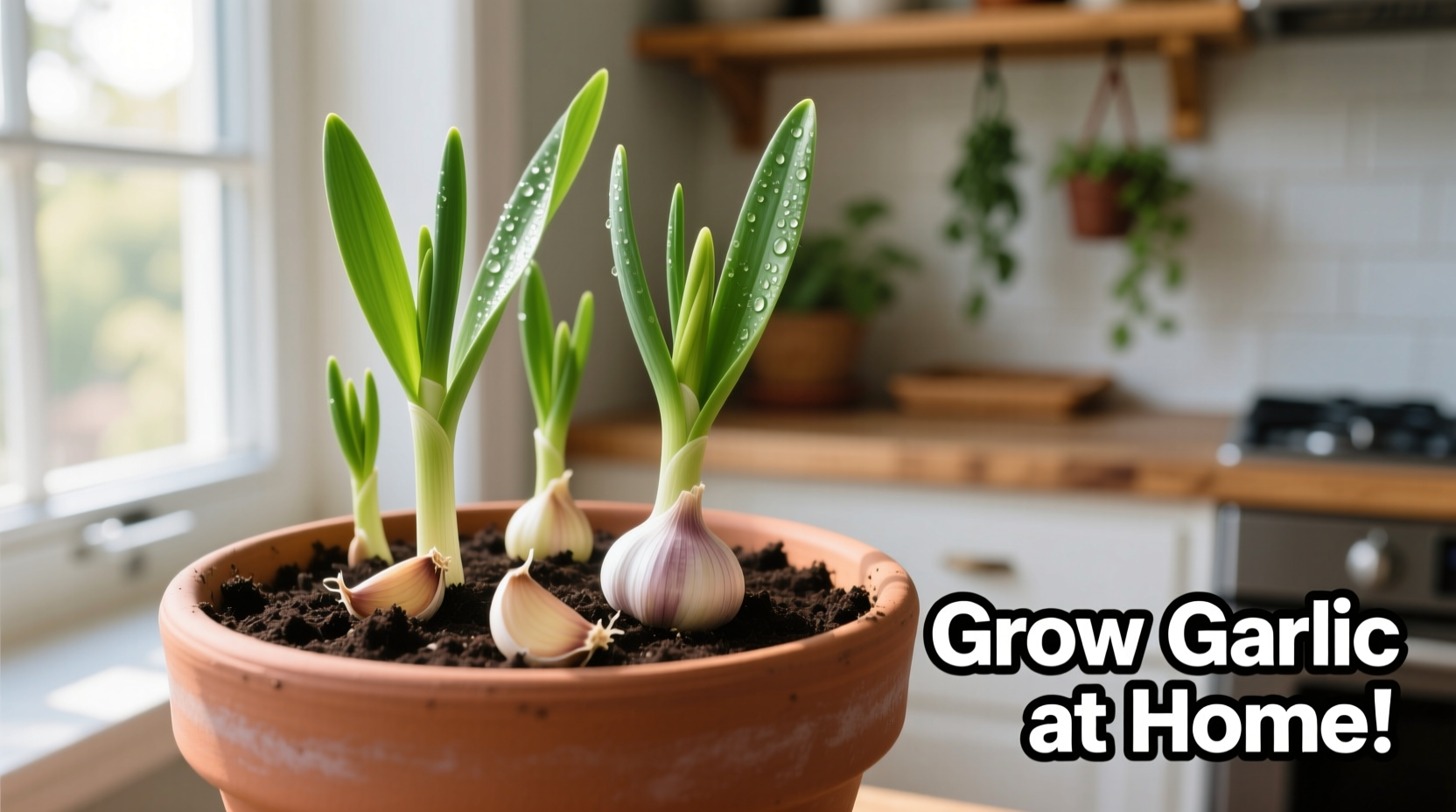Why Container Garlic Growing Works for Small Spaces
Garlic adapts remarkably well to container cultivation when you understand its basic requirements. Unlike many root vegetables, garlic develops compact bulb structures that thrive in confined spaces as long as they receive proper care. The key advantage of pot cultivation is complete control over soil conditions - crucial since garlic requires excellent drainage to prevent bulb rot. Urban gardeners across North America have successfully harvested full-sized bulbs from containers on balconies, patios, and even fire escapes.

Essential Container Requirements
Selecting the right container makes or breaks your garlic growing success. Most gardeners underestimate the depth garlic roots require. University agricultural extensions consistently recommend containers with these specifications:
| Container Feature | Minimum Requirement | Ideal Specification |
|---|---|---|
| Depth | 8 inches | 10-12 inches |
| Diameter | 6 inches per bulb | 12-14 inches for 3-4 bulbs |
| Material | Any with drainage | Terracotta or fabric pots |
| Drainage Holes | At least 2 | 4-6 evenly spaced |
According to the University of Minnesota Extension, fabric grow bags provide superior root aeration compared to plastic containers, reducing the risk of waterlogged soil that causes bulb rot. Terracotta pots also help regulate moisture but require more frequent watering during hot periods.
Best Garlic Varieties for Container Growing
Not all garlic performs equally well in containers. Softneck varieties generally adapt better to container environments than hardneck types due to their smaller bulb size and greater temperature tolerance. The Royal Horticultural Society recommends these varieties for pot cultivation:
- Inchelium Red - Reliable producer with medium-sized bulbs
- Silverskin - Excellent storage qualities, thrives in containers
- California Early - Fast maturing, ideal for shorter growing seasons
- Chet's Italian Red - Performs well in various container sizes
Hardneck varieties like Music or German Extra Hardy can work in larger containers (10+ gallons) but require deeper soil and more consistent moisture. The Royal Horticultural Society notes that softneck varieties typically produce more consistent results in containers due to their adaptability.
Step-by-Step Container Planting Process
Follow this proven sequence for successful garlic cultivation in pots. Timing matters significantly - fall planting yields larger bulbs than spring planting in most climates.
Planting Timeline
Understanding the garlic growth cycle helps optimize your container gardening schedule:
- September-October: Plant cloves 4-6 weeks before first frost
- November-January: Root development period (keep soil moist)
- February-March: Top growth resumes as temperatures warm
- April-May: Bulb formation phase (critical watering period)
- June-July: Harvest when 1/3 of leaves turn brown
Planting Instructions
- Fill container with 2 inches of premium potting mix (avoid garden soil)
- Place cloves pointy-end up, 2 inches deep, 4-6 inches apart
- Cover with 2 inches of soil mix and water thoroughly
- Add 2-inch mulch layer (straw or shredded leaves) after planting
- Move containers to a sunny location (6+ hours direct sunlight daily)
Container-Specific Care Requirements
Garlic in pots has different needs than garden-grown garlic. Container soil dries out faster and nutrients deplete more quickly.
Watering Strategy
Maintain consistent moisture without waterlogging. The Oregon State University Extension recommends this watering schedule:
- Fall (after planting): Water weekly if no rain
- Winter: Water only if soil dries completely
- Spring (active growth): Water when top inch feels dry
- 6 weeks before harvest: Reduce watering to dry soil slightly
Fertilizing for Maximum Bulb Development
Container garlic needs regular feeding since nutrients leach from frequent watering:
- Apply balanced organic fertilizer (10-10-10) at planting time
- Side-dress with nitrogen-rich fertilizer (blood meal) in early spring
- Stop fertilizing 4 weeks before expected harvest date
- Consider liquid seaweed feed every 2-3 weeks during active growth
Common Container Growing Challenges and Solutions
Container garlic presents unique challenges that differ from garden cultivation. Recognizing these early prevents crop failure.
Temperature Extremes
Containers experience wider temperature fluctuations than garden soil. During winter:
- Move pots against south-facing walls for heat retention
- Group containers together for mutual insulation
- Add extra mulch (4-6 inches) when temperatures drop below 20°F
- Consider moving containers to unheated garage during extreme cold
Container-Specific Pest Management
While containers reduce some soil-borne diseases, they don't eliminate all threats:
- Onion maggots: Use floating row covers immediately after planting
- White rot: Rotate containers annually; never reuse soil for alliums
- Aphids: Spray with insecticidal soap at first sign of infestation
- Prevention: Include companion plants like marigolds in nearby containers
Harvesting and Curing Container-Grown Garlic
Knowing when and how to harvest determines your storage success. Container-grown garlic often matures slightly earlier than garden-grown due to warmer root zones.
Harvest Indicators
Watch for these visual cues that signal harvest time:
- Lower third of leaves turn brown while upper leaves remain green
- Bulb wrappers become dry and papery
- Individual cloves fill the wrapper completely
- Soil around container starts to pull away from sides
Curing Process
Proper curing ensures long storage life for your container harvest:
- Gently dig up entire plant (don't pull by stems)
- Shake off excess soil (don't wash bulbs)
- Hang in warm, dry, dark location with good air circulation
- Cure for 3-4 weeks until necks are completely dry
- Trim roots and stems, brush off remaining soil
- Store in mesh bags in cool, dark location (55-65°F)
Container Growing Limitations to Consider
While growing garlic in pots works well, understand these context boundaries before starting:
- Yield per square foot is lower than garden beds (typically 1-2 bulbs per 1-gallon container)
- Requires more frequent watering during hot weather
- Winter protection needed in zones 6 and colder
- Soil nutrients deplete faster requiring regular feeding
- Container size limits maximum bulb size compared to garden cultivation
Despite these limitations, container garlic growing remains an excellent option for urban gardeners. The University of Illinois Extension confirms that properly managed container garlic can produce bulbs 70-80% the size of garden-grown counterparts.
Final Tips for Container Garlic Success
Implement these professional techniques to maximize your harvest:
- Use a soil thermometer to ensure planting when soil reaches 50-60°F
- Plant individual cloves from organic garlic (supermarket garlic often treated)
- Elevate containers on feet to improve drainage and prevent waterlogging
- Rotate container position weekly for even sun exposure
- Try double-potting in extremely cold climates (nest pot inside larger one)
Frequently Asked Questions
How deep should I plant garlic cloves in containers?
Plant garlic cloves 2 inches deep in containers, measured from the tip of the clove to the soil surface. In colder climates (zones 4-6), increase depth to 3 inches and add extra mulch for winter protection. Proper planting depth prevents premature sprouting in fall while protecting cloves from temperature extremes.
Can I grow garlic in small pots like 1-gallon containers?
Yes, but with limitations. A 1-gallon container (12-inch diameter) can accommodate 1-2 garlic plants. Expect smaller bulbs compared to larger containers. For best results in small pots, choose softneck varieties like Silverskin which produce smaller bulbs. Remember that smaller containers require more frequent watering and feeding due to limited soil volume.
How often should I water garlic in containers during summer?
During summer's active growth phase, check container soil daily. Water when the top inch feels dry - typically every 2-3 days in warm weather. Increase frequency during heat waves. Reduce watering significantly 3-4 weeks before harvest when leaves begin yellowing. Container garlic needs more frequent watering than garden-grown because potting soil dries out faster.
Why are my container-grown garlic leaves turning yellow prematurely?
Premature yellowing usually indicates overwatering or nutrient deficiency. Check soil moisture - soggy soil causes root rot. If soil is too wet, reduce watering and improve drainage. If soil is dry, yellowing suggests nitrogen deficiency - apply liquid fish emulsion. Also check for pests like onion thrips which cause yellow streaks on leaves. Container garlic needs consistent moisture but never waterlogged conditions.
Can I grow garlic indoors in containers year-round?
You can grow garlic greens indoors year-round, but full bulb development requires specific conditions difficult to achieve indoors. Bulb formation needs 4-8 weeks of temperatures below 40°F (vernalization). Without this cold period, garlic produces only greens. For indoor bulb production, place containers in an unheated garage or cold frame during winter months before moving to a sunny indoor location in spring.











 浙公网安备
33010002000092号
浙公网安备
33010002000092号 浙B2-20120091-4
浙B2-20120091-4